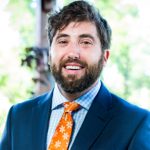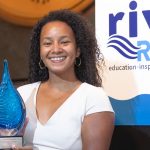Alicia Smith
Toledo, Ohio
Alicia is the proud mother of three. She and her family currently reside in Toledo, Ohio, and she is a proud native of Detroit, Michigan. Alicia is the Community Engagement Director for Freshwater Future and the Community Liaison for Junction Coalition, in Toledo, Ohio. She lives, works, and enjoys the Junction community’s natural social environment with neighbors, friends, family, and visitors. Alicia’s passion flows from her belief that all citizens need information to thrive. As such, she works to build the capacity of each family. She believes that Justice work is not limited to the environment but touches on issues of social and economic justice with the goal of promoting peace, public health, and a better quality of life for all citizens. Junction Coalition started as an opportunity to help the community help themselves, learning to collaborate with anchor institutions, and share collective work. During the 2014 Algae Bloom (Outbreak), Junction Coalition was pushed into environmental action. Families were in need of support, information, and education not just for the few days of the crisis but a continuum of support and interaction for safe, clean, and affordable drinking water.
Alicia was awarded the Environmental Justice & Equity Expert Award by the Urban Waters Learning Network in 2020. Watch the awards ceremony.
This interview was conducted by Carly Schmidt on September 22, 2020. Learn more about Alicia’s work at FreshwaterFuture.org.
What is your role at Freshwater Future?
I am the Community Engagement Director for Freshwater Future. I also have a role within Toledo, Ohio, not only representing Freshwater Future but also community members who are dependent upon the Western Lake Erie Basin for residential water. I work as a community liaison to connect environmental justice and social justice. I do the same thing for all Great Lakes communities with which we engage at Freshwater Future, whether it be diversity, equity, and inclusion, or education and advocacy, or policy reform. I work to lift up the voice of the community members, especially our most vulnerable residents.
How did you get involved in the Urban Waters Learning Network (UWLN)?
I became involved in UWLN sometime back in 2016. Katie Rousseau (American Rivers) invited me to gain more of an understanding of the education efforts happening in the group. Then, I started working with the Toledo Metropolitan Area Council of Government on the efficacy of green infrastructure for the management of stormwater in legacy neighborhoods with aging combined sewers. We Toledoans were already working on increasing the cost of residential water: our water bills were skyrocketing and will continue to skyrocket almost at 37% within the next year. Toledo’s historic communities were suffering from combined sewer systems, lead pipes, and faulty infrastructure, so we started to partner with organizations such as Freshwater Future, River Network, American Rivers, Partners for Clean Streams, and others to uplift the fact that urban communities were suffering. We were able to partner with these groups through UWLN, and from that, we were able to install the largest bioswales in the community and activated young people through the citizen science practice of lead testing in neighborhood homes.
We didn’t look at water only; we looked at air and the patterns that come out of poor environmental quality, like asthma, and realized that environmental health is a social justice issue. There’s no way to talk about one without the other. In every room where environmental quality is being discussed, there needs to be a public health expert. Public health is inextricably bound to good environmental practices. Clean water, clean air, good soil for growing healthy food are basic community needs.
In your UWLN Award acceptance speech, you talked about the intersection of advocacy and education. How important is that intersection today?
People need to first understand how their environment impacts their health to begin the process of education and advocacy. Think about the case of a child who’s not performing at school or is not performing cognitively as well as that child should be. Then, you go into their home and discover that they’ve been exposed to lead. That is an environmental injustice. So, what are we doing from a social and public health aspect to ensure that children and their families are receiving services and support? That’s where we began to call the community together, not only in Toledo but in Flint as well. It is one thing to say that there was harm done to a community, but what do recovery and healing look like? Recovery and healing start with education. People must be informed and there must be community voice as we develop policy.
How did we write a stimulus package without asking people what they themselves need as families, neighborhoods, and communities? Right now, so many families are still living without residential water, and water is a basic human need. Freshwater Future worked on the frontlines of getting people’s water turned back on. Freshwater Future did this because when you listen to the CDC and health recommendations, the one thing that people had to do to combat COVID-19 was to keep their hands washed and clothes clean. That cannot be done without a secure residential water supply.
We decided that we had to get these families together who were affected. We went to frontline community organizations in Benton Harbor, Detroit, Flint, Duluth, etc. You cannot engage communities without knowing the people who live there. We discovered that families didn’t know about lead and its impacts on cognitive development, or that you need water filters, or that you need to flush. So, we began to educate. Yes, we want feasible, workable infrastructure, but there’s not equity in that process and we need to find a way to put some of that money back into the community. If we’re going to create new infrastructure, then we need to teach the children who live there how to maintain their homes and property and put additional funding in place to make education a priority.
It sounds like you are really doing the work to work with communities. How are you empowering them to get involved in the political process?
Yes, that’s our whole purpose. There’s nothing like going into the community and asking them what they need. Let’s take a few minutes, for every grant proposal, to talk to an affected community. Let’s learn what residents want because, if you do that, their efforts will continue after we’re gone.
It’s also about education and empowerment. I always say, “you are your own Superman.” You are enough, as a representative of your community, and you have power. We try to empower communities by telling them who their council members are and how to work with them. You elect your Mayor, the person who should be building on your agenda, not theirs. These are the things that we have to start saying to a community. When we’re encouraging people to vote and get involved, we tell them that it is paramount that each candidate must have an environmental justice platform and an adequate grasp of economic and social conditions in the communities candidates will serve.
What are the roles of community education and empowerment leading up to the November election?
As a Black woman, who has been required to be resilient while we continue to lose young Black lives, I have to consider the most impacted communities when it comes to environmental and public health disparities. This goes all the way back to neighborhood redlining, to not having adequate education, and to the displacement of residents because of gentrification. We have to know who our politicians are and how they should move on our behalf.
We, as a community, must have a better understanding of the policies, laws, and regulations that you’re governed by and how elected officials represent you. When a politician is functioning principally in spaces that are beneficial to particular populations, it hurts everybody. We have to look at the world with a holistic vision. Whatever the racial and ethnic makeup of particular communities and neighborhoods, our most vulnerable citizens, principally children, are in need of economic, social, and environmental justice practices which will ensure a secure future for all.
There is no report card for politicians. We need to know what the politicians are doing, how they did it, why they did it, how did it impact our health. Look at the Clean Water Act and how rollbacks have decreased protections of our most basic resource! We need a candidate who understands the implications and who will protect us. Where is the environmental justice agenda for 2020? If we build an agenda, who informs it? Have we gone into communities and had the important conversations? We’re always working at the tail end instead of the front end. Every year, we should be having these conversations.
So, we go into communities and educate them about the proximity and causes of some of their most prevalent environmental and health problems. But we don’t want to educate without giving people a resolve. When people are informed, they are resolved to make change. We need to listen to what the community needs, make a plan with residents to address those needs and reflect on what we’ve learned before we implement the plan to address those needs.
Freshwater Future asks what community environmental initiatives are. We have partnered with We the People of Detroit to put together a list of 10 “must-haves” based on conversations with communities. We also need to look at issues from a social impact. Decisions are made based on economic development, but environmental, social, and economic justice are inseparable. And then, as we create our environmental initiatives, we have to make sure that people are ready with adequate workforce development and education. Our youth citizen science program, for example, is working to prepare our youth for green jobs in the future.
You are a co-leader of the Equitable Infrastructure group within the Urban Waters Learning Network. What about this initiative drew you in?
Well, I don’t ever want to be involved! Right now, I’m trying to run from new projects. But I understand that I have a responsibility and to whom much is given, much is required; and I’ve been given people who love and appreciate me, regardless of my temperament. You can be compassionate to the point of anger. James Baldwin said, “to be Black in America is to be in a constant state of rage.”
I chose to serve on the committee because, for too long, we’ve forgotten that we displace people when we “develop” a space. We don’t listen or take the temperature of that community. We don’t consider that the revenue from new developments should go back to those community members. We don’t do the homework when we develop programs without community consultation, and it does incredible harm. We need folks standing in the trenches to say “enough is enough.” I’m very thankful that the Urban Waters Learning Network is asking how we look at development differently, how do we elevate the voices of these communities, and how to bring to light the historical harm with a view to reducing that harm.
So many members of the network can empathize with your trying to say no and do less. Do you have any self-care advice for other water leaders like yourself?
It’s called “personal ecology” at the Rockwood Leadership Institute. I had the pleasure of going through that training and I didn’t know about this idea until this training. The idea is: I can’t be what I need to be for everyone else if I’m not what I need to be for myself. So, I’m learning to turn off after work hours and find partners with whom to commiserate. I’m very grateful for folks like Jill Ryan (Executive Director at Freshwater Future) for their support. The culture here at Freshwater Future is really community working for the community.
What would you say to other organizations looking to find their role in their community in the upcoming election?
Freshwater Future has been doing the work to move in the space of education, advocacy, and public health in the context of water equity, but we couldn’t do it without our partners to make sure that equity is at the forefront of our work. Basically, none of this is possible without good partners who respect and love the community. It’s about doing to best we can together with and for others.







